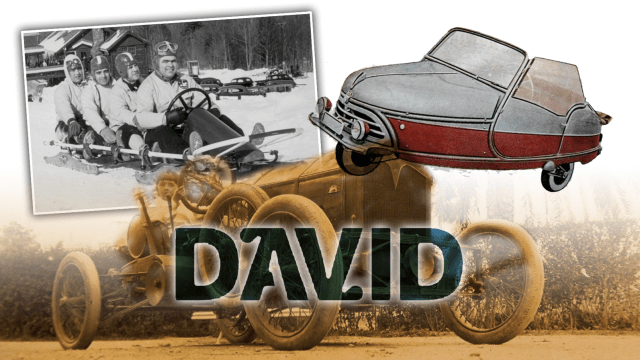Car companies often have interesting origin stories. Sometimes they evolved from making non-car things to cars, sometimes it was about cars from the start, and sometimes they don’t even want to talk that much about how they started because maybe Nazis were involved. But there’s only one example I can think of where a carmaker was started because a kid wanted to bobsled in a warm climate, and that carmaker is called David.
Yes, an entire, reasonably successful car company was started because in 1907 a 17-year-old kid named José Maria Armangué wanted to be a bobsledder. Armangué was supposed to represent Spain (or perhaps just Catalonia, but that whole thing is sort of touchy right now) in a bobsled competition in France.
The problem was that Spain isn’t the snowiest of countries, so practicing became an issue. Being a clever young bobsledder, Armangué modified his bobsled to have wheels, which allowed him the ability to practice fast downhill runs even when there wasn’t any snow.
Years later, in 1913, Armangué finally got sick of dragging his wheeled bobsled up mountains all the time, so he, along with his two brothers and some friends, installed a motor into the bobsled to allow it to haul itself up the mountains for a change, instead of being some filthy freeloading bobsled.
At some point in this process, Armangué realised, hey, a bobsled with wheels and a motor is basically… a car.
So, they called their 1913 contraption David, after the noted biblical rock-sling aficionado who liked to kill giants, and got some investment capital the next year to start the “National Autocycle Factory David” company, where they began series production of David cyclecars.
At that time in Spain and really all over Europe, cheap crude small cars known as cyclecars were quite popular, giving huge numbers of people their very first introduction into car ownership and motoring of any kind.
These early David cyclecars were actually pretty refined, for cyclecars, at least. They boasted an 1131cc inline-four, water-cooled engine, and could reach about 80km/h with a huge belt driving a rear wheel.
That big drive belt was part of a belt and pulley system that gave the David 16 speeds, which is insane. I haven’t found much more technical data on it, but it seems to be some sort of “stepped” CVT. One machine-translated site suggests it was based on “trapezoidal belts.”
The cars had pretty minimal bodywork, mostly consisting of a house-shaped engine enclosure and some seats on an otherwise bare chassis, but some models gained such indulgent luxuries as fenders and lights, and full bodies were available for those with a bit more cash to spend.
The radiator had a distinctive central fang design, and the cars had a spindly, racy look about them that somehow managed to feel more like a ‘real car’ than many of its contemporaries.
Before the Spanish Civil War, David also produced taxis, which were based on Citroën platforms. Over a thousand of these cabs were in service in Barcelona just prior to the war, and David also ran a Citroën dealership in this period as well, which explains where they got all those chassis.
After the Civil War, Spain was in bad shape, with severe shortages of fuel. David proved itself to be a remarkably adaptable company, making a small run of electric cars based on Citroën chassis.
Later, in 1949, David re-invented itself again, returning to its origins as a maker of cheap, simple, accessible cars for the everyperson. By this time, the solution to that problem wasn’t cyclecars, but microcars.
The David microcar was designed by José Mª Moré Comas around 1951, and was a three-wheeled design with styling that seemed to acknowledge the company’s bobsled origins.
Of the three-wheeled design, Comas described it as
“… it is not a car with one less wheel, but a motorcycle with one more wheel.”
This new David of the ’50s used an air-cooled single-cylinder 345cc engine that made 10 hp, with a top speed of about 68km/h.
Competition was pretty intense in the Spanish microcar market, with the most successful of the microcars being the Voisin-designed Biscúter. Still, the David was a part of the Spanish microcar scene, remaining in production for about ten years, with around 75 copies made.
All of this is pretty good for a company that was started because some Catalonian teen was too lazy to keep dragging his wheeled bobsled uphill. The actual King David would have been proud.
